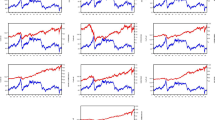Abstract
This paper is the first study to examine the effectiveness of the Shanghai Fuel Oil Futures Contract (SHF) in risk reduction on the Chinese energy oil market. We find that the SHF contract can help investors reduce risk by approximately 45 %, lower than empirical evidence in developed markets, when weekly data are applied. In contrast, when using daily data, SHF contract can only help reduce risk by approximately 9 %. However, the Tokyo Oil Futures Contract performs two times better and reduces risk by about 17 %. The empirical results are robust when variance complicated bivariate GARCH and bivariate distributions are used. Our results imply that the energy oil futures market in China is not well-established and more policies are needed to improve market efficiency.
Similar content being viewed by others
Notes
Previous studies usually collect the data for the nearby futures contract until the contract reaches either the first day of the delivery month or its expiry date.
References
Baillie, R., & Myers, R. J. (1991). Bivariate GARCH estimation of the optimal commodity futures hedge. Journal of Applied Econometrics, 6(2), 109–124.
Bauwens, L., & Laurent, S. (2005). A new class of multivariate skew densities with application to GARCH models. Journal of Business and Economic Statistics, 23(3), 346–354.
Bollerslev, T. (1990). Modelling the coherence in short-run nominal exchange rates: a multivariate generalized ARCH model. Review of Economics and Statistics, 72(3), 498–505.
Brown-Hruska, S., & Kuserk, G. (1995). Volatility, volume and the notion of balance in the S&P 500 cash and futures market. Journal of Futures Markets, 15(6), 677–689.
Cerrato, M., Peretti, C., Larsson, R., & Sarantis, N. (2011). A nonlinear panel unit root test under cross section dependence. University of Glasgow Business School-Economics Working Paper, 2011/08.
Chakraborty, A., & Barkoulas, T. J. (1999). Dynamic futures hedging in currency markets. European Journal of Finance, 5(4), 299–314.
Chan, K., Chan, K. C., & Karolyi, G. (1991). Intraday volatility in the stock index and stock index futures markets. Review of Financial Studies, 4(4), 652–684.
Collins, R. A. (2000). The risk management effectiveness of multivariate hedging models in the Soy complex. Journal of Futures Markets, 20(2), 189–204.
Engle, R. (2002). Dynamic conditional correlation: a simple class of multivariate generalized autoregressive conditional heteroskedasticity models. Journal of Business and Economic Statistics, 20(3), 339–360.
Engle, R. F., & Kroner, K. F. (1995). Multivariate simultaneous generalized ARCH. Econometric Theory, 11(01), 122–150.
Faff, R. W., & McKenzie, M. D. (2002). The impact of stock index futures trading on daily returns seasonality: a multicountry study. The Journal of Business, 75(1), 95–125.
Gur, N. (2012). Financial constraints, quality of institutions and firm size: what do perceptions tell us? Eurasian Economics Review, 2(2), 17–36.
Illueca, M., & Lafuente, J. (2003). The effect of spot and futures trading on stock index market volatility: a nonparametric approach. Journal of Futures Markets, 23(9), 841–858.
Kroner, K. F., & Sultan, J. (1993). Time-varying distributions and dynamic hedging with foreign currency futures. Journal of Financial and Quantitative Analysis, 28(04), 535–551.
Lau, C. K. M. (2009). A more powerful panel unit root test with an application to PPP. Applied Economics Letters, 16(1), 75–80.
Lau, C. K. M., & Bilgin, M. H. (2013). Hedging with Chinese aluminum futures: international evidence with return and volatility spillover indices under structural breaks. Emerging Markets Finance and Trade, 49(S1), 37–48.
Lau, C. K. M., Demir, E., & Bilgin, M. H. (2013). Experience-based corporate corruption and stock market volatility: evidence from emerging markets. Emerging Markets Review, 17, 1–13.
Lau, C. K. M., Suvankulov, F., Su, Y., & Chau, F. (2012). Some cautions on the use of nonlinear panel unit root tests: evidence from a modified series-specific non-linear panel unit-root test. Economic Modelling, 29(3), 810–816.
Lien, D. (2009). A note on the hedging effectiveness of GARCH models. International Review of Economics and Finance, 18(1), 110–112.
Lien, D., Tse, Y. K., & Tsui, A. K. (2002). Evaluating the hedging performance of constant-correlation GARCH model. Applied Financial Economics, 12(11), 791–798.
Moon, G. H., Yu, W. C., Hong, C. H., & Chen, Y. C. (2010). Risk management of commodities with hedging strategies. Winona State University Working Paper.
Moosa, I. A. (2003). The sensitivity of the optimal hedge ratio to model specification. Finance Letters, 1(1), 15–20.
Park, S. Y., & Jie, S. Y. (2009). Estimation and hedging effectiveness of time-varying hedge ratio: flexible bivariate GARCH approaches. Journal of Futures Markets, 30(1), 71–99.
Puigvert-Gutierrez, J. M., & de Vincent-Humphreys, R. (2012). A quantitative mirror on the EURIBOR market using implied probability density functions. Eurasian Economic Review, 2(1), 1–31.
Salvador, E., & Arago, V. (2013). Measuring hedging effectiveness of index futures contracts: do dynamic models outperform static models? A regime-switching approach. Journal of Futures Markets, 34(4), 299–398.
Tanai, Y., & Lin, K. P. (2013). Mongolian and world equity markets: volatilities and correlations. Eurasian Economic Review, 3(2), 139–167.
Tse, Y. K., & Tsui, A. K. C. (2002). A multivariate generalized autoregressive conditional heteroscedasticity model with time-varying correlations. Journal of Business and Economic Statistics, 20(3), 351–362.
West, K. D., & Cho, D. (1995). The predictive ability of several models of exchange rate volatility. Journal of Econometrics, 69(2), 367–391.
Zanotti, G., Gabbi, G., & Geranio, M. (2010). Hedging with futures: efficacy of GARCH correlation models to European electricity markets. Journal of International Financial Markets, Institutions and Money, 20(2), 135–148.
Author information
Authors and Affiliations
Corresponding author
Rights and permissions
About this article
Cite this article
Lau, M.C.K., Su, Y., Tan, N. et al. Hedging China’s energy oil market risks. Eurasian Econ Rev 4, 99–112 (2014). https://doi.org/10.1007/s40822-014-0003-4
Received:
Revised:
Accepted:
Published:
Issue Date:
DOI: https://doi.org/10.1007/s40822-014-0003-4
Keywords
- China energy oil market
- Hedging risk performance
- Bivariate GARCH model
- Shanghai fuel oil futures contract (SHF)
- Tokyo oil futures contract (TKF)




